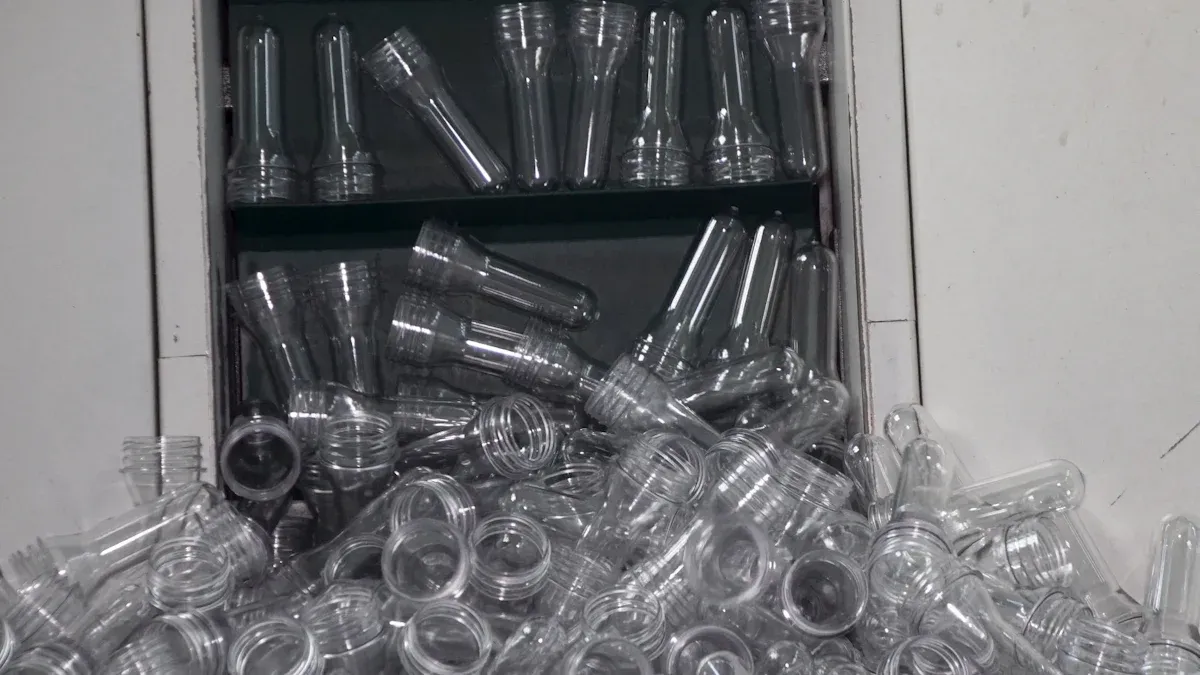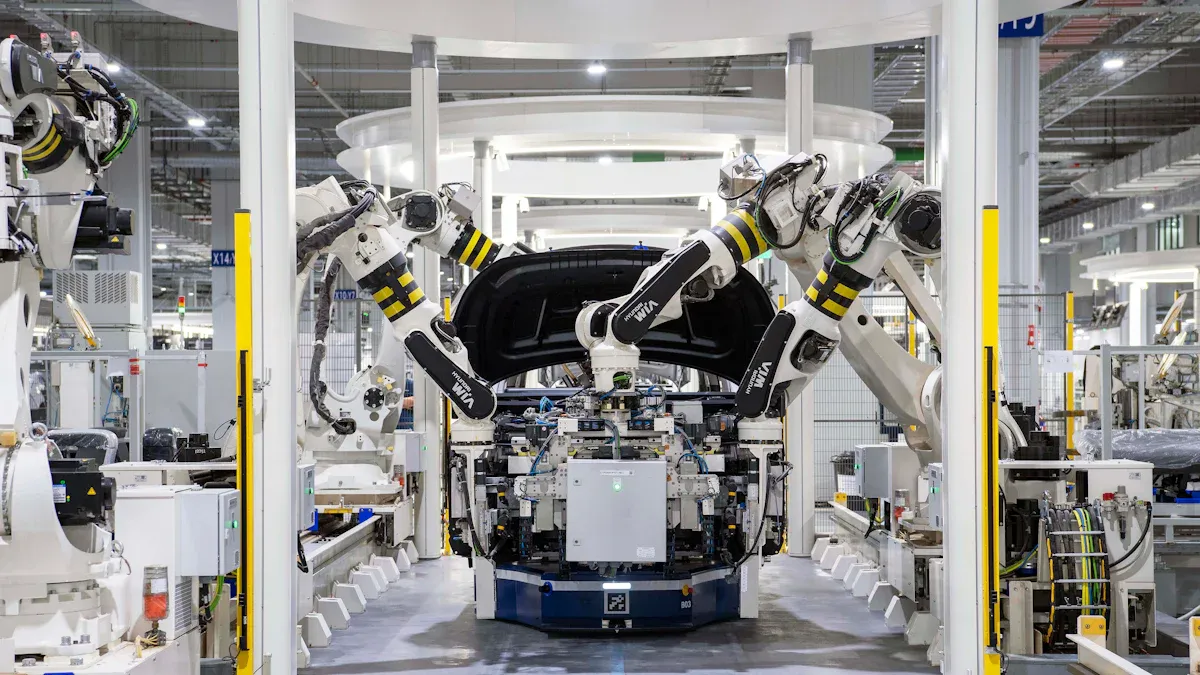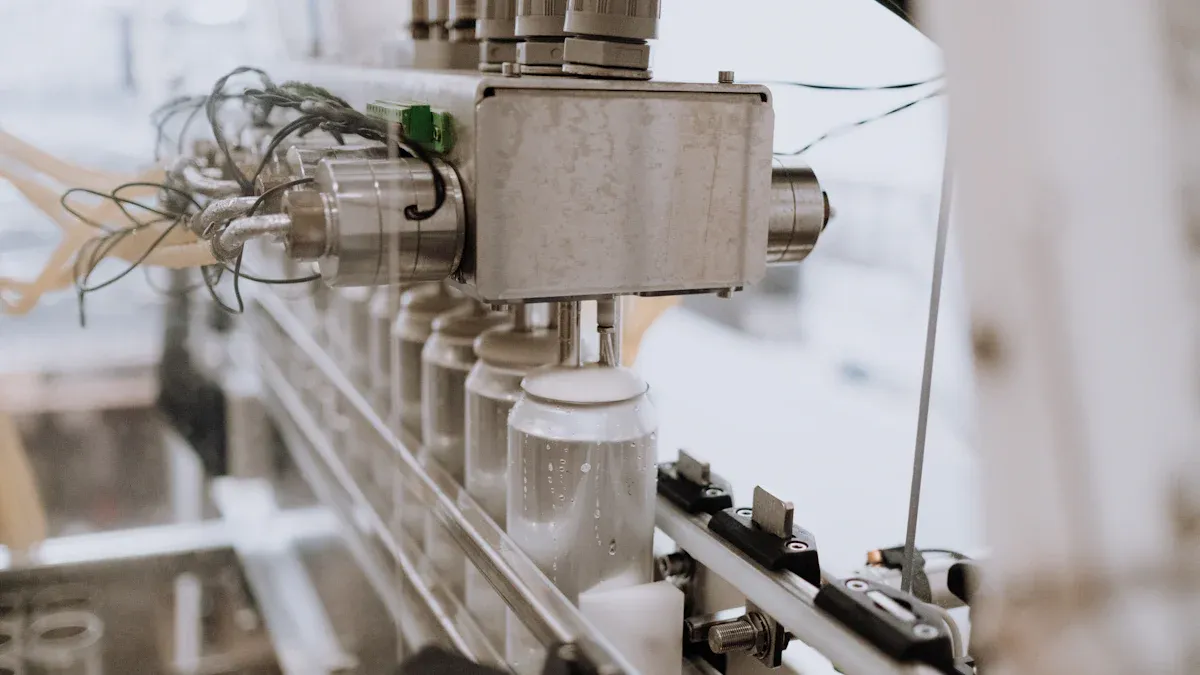
Reducing costs in injection molding is essential for high-volume production runs, especially when aiming to lower costs. When producing thousands of parts, even a small reduction in the price-per-piece cost can lead to significant savings. For example, in high-volume production of 100,000 to 300,000 parts, the cost per part can drop to $1.75 compared to $4.5 in low-volume production. This low per-unit cost allows you to maximize your profits while remaining competitive in the market.
Adopting smart strategies can further help lower costs. Techniques like real-time process monitoring and proper part positioning can improve efficiency and eliminate waste. These methods not only enhance production but also ensure long-term savings. By focusing on cost-effective practices, you can achieve better results without compromising quality.

Simplifying part geometry is one of the most effective ways to achieve cost reduction in injection molding. By removing unnecessary features, you can reduce material usage and streamline the manufacturing process. For example, eliminating intricate details minimizes the need for complex molds, which can significantly lower production costs. Additionally, simpler designs often lead to faster cycle times, allowing you to produce more parts in less time.
| Strategy | Impact on Cost Efficiency |
|---|---|
| Design Optimization | Reduces material usage and simplifies part geometry. |
| Multi-Cavity Molds | Amortizes mold costs over more parts, reducing price-per-piece. |
| Eliminating Unnecessary Features | Lowers manufacturing costs by simplifying geometry. |
By focusing on intelligent mold design, you can ensure that your parts are both functional and cost-effective.
Undercuts and complex features in mold designs often lead to higher costs. These elements require additional tooling, such as sliding cores, which increases both the complexity and expense of the mold. By eliminating undercuts, you can simplify the mold design and reduce the costs associated with production. This approach also improves the efficiency of the injection molding process, as simpler molds allow for faster part ejection and shorter cycle times.
For instance, manufacturers who prioritize intelligent mold design and avoid undercuts often experience significant cost savings. Simplified designs not only reduce tooling costs but also enhance overall production efficiency.
Using standardized mold components is another way to optimize design and lower cost. Standardized tooling options, such as MUD inserts, allow you to use a master mold frame. This reduces the need for custom molds, which can be expensive. For low to medium production runs, this approach is particularly beneficial. It enables you to maintain quality while keeping costs under control.
By adopting universal molds and standardized components, you can achieve cost reduction without compromising on part quality. This strategy ensures that your injection molding process remains efficient and budget-friendly.
Choosing the right materials plays a crucial role in reducing injection molding costs. You need to balance material properties with cost considerations to ensure optimal performance without overspending. Material selection significantly impacts both the functionality and the overall manufacturing costs of your product. For example:
| Factor | Description |
|---|---|
| Material type | Amorphous or semi-crystalline |
| Material cost | Based on order quantity |
| Scrap factor | Expected waste during production |
| Material additives | Additional components affecting cost |
| Colorant cost | Costs associated with coloring materials |
By carefully evaluating these factors, you can strike the right balance between cost and performance, ensuring your injection molding process remains efficient and cost-effective.
Incorporating recycled or regrind materials is another effective way to reduce injection molding costs. You can mix up to 30% of compatible regrind material with virgin material without compromising the mechanical properties of your product. This approach not only lowers material costs but also supports sustainable manufacturing practices.
For instance, using 30% regrind material can lead to approximately 15% cost savings. This strategy works particularly well for non-critical parts where minor variations in material properties are acceptable. However, you should monitor the quality of recycled materials to avoid defects or inconsistencies in your final product.
By adopting this method, you can achieve significant savings while contributing to environmental sustainability.
Negotiating bulk discounts with suppliers can lead to substantial cost reductions in injection molding. High-volume production allows you to secure discounts of 5%-10% on materials like resin or mold steel. Building strong relationships with suppliers is key to achieving these savings.
When you establish trust with your suppliers, they are more likely to offer competitive pricing, better quality, and reliable delivery schedules. This not only reduces material costs but also improves overall business efficiency. Additionally, planning your material purchases in advance can help you avoid price fluctuations caused by market demand or external factors like crude oil prices.
By leveraging bulk discounts and fostering supplier relationships, you can effectively manage costs and enhance your injection molding operations.
Reducing cycle times is one of the most effective ways to improve efficiency in injection molding. Shorter cycles allow you to produce more parts in the same amount of time, which directly lowers production costs. For example, a manufacturer who reduced their cycle time from 9.5 seconds to 5.0 seconds achieved an 88% increase in daily output. By implementing a higher-cavitation tool, they further boosted production to 275,000 parts per day, a 150% increase. This approach enabled them to recover their tooling investment in less than six months.
Shorter cycle times also reduce energy consumption, which contributes to lower overhead costs. Quicker production runs mean you can bring your products to market faster, giving you a competitive edge. To achieve this, focus on optimizing cooling times, improving mold designs, and using advanced materials that cool more quickly.
Automation in injection molding can significantly reduce the costs associated with labor and material waste. Automated systems operate continuously, minimizing downtime and ensuring consistent quality. Reports show that automation can lower production costs by up to 25%. This is achieved through reduced labor requirements and less material waste.
Robotic systems, for instance, can handle repetitive tasks like part removal and assembly with precision. This not only speeds up production but also reduces the risk of human error. By automating your processes, you can optimize production efficiency while maintaining high-quality standards. Additionally, automation allows you to scale your operations without a proportional increase in labor costs.
Fine-tuning your machine settings can lead to significant cost savings in injection molding. Properly calibrated machines ensure consistent output, reducing defects and rejects. This improves product quality and minimizes waste. For example:
| Aspect | Benefit |
|---|---|
| Consistent Output | Reduces defects and rejects, improving product quality. |
| Increased Productivity | Reduces cycle times, leading to more parts produced per hour. |
| Energy Efficiency | Minimizes energy wastage, lowering operating costs. |
| Waste Reduction | Decreases scrap and rejected parts, saving material costs. |
Optimizing settings like injection speed, pressure, and temperature can also enhance energy efficiency. This reduces operating costs while maintaining production quality. Regularly monitoring and adjusting these parameters ensures that your processes remain efficient and cost-effective.

Regular mold maintenance is essential for keeping your injection molding operations efficient and cost-effective. By maintaining molds, you can prevent unscheduled stops and reduce defects, which directly lowers production costs. For example, routine inspections and cleaning ensure that molds operate at peak performance, minimizing downtime and extending their lifespan. This proactive approach also helps you avoid costly repairs or replacements, safeguarding your investment.
Regular maintenance enhances efficiency by reducing cycle times. Shorter cycles mean you can produce more parts in less time, improving overall productivity. Additionally, well-maintained molds deliver consistent quality, reducing the likelihood of defective parts and material waste. By prioritizing maintenance, you can achieve long-term savings and maintain a competitive edge in the injection molding industry.
Applying specialized coatings to molds can significantly enhance their durability and performance. These coatings increase surface hardness, making molds more resistant to wear and tear. For instance:
Proprietary coatings achieve surface hardness levels of Rc 80 to 85, surpassing standard tool steels. This improvement extends tool life and reduces residue build-up, leading to fewer maintenance requirements.
Customers have reported mold lifetimes increasing from 100,000 cycles to over 1,000,000 cycles after applying PVD coatings. This reduces downtime and machining costs, making the process more efficient.
By investing in coatings, you can reduce the frequency of repairs and replacements, ensuring your molds remain cost-effective over time.
Multi-cavity molds allow you to produce multiple parts in a single cycle, significantly improving efficiency. These molds reduce downtime by minimizing the number of cycles needed to meet production targets. They also lower the price per part by distributing fixed costs across more units. For example:
| Evidence Type | Description |
|---|---|
| Reduced Downtime | Fewer cycles needed to achieve the same output minimizes machine downtime, enhancing productivity. |
| Increased Production Speed | Higher quantity of parts produced in a shorter time frame meets tight deadlines efficiently. |
| Cost-Effectiveness | Lower price per part due to more parts produced per cycle, distributing fixed costs across more units. |
| Energy Efficiency | Fewer molding cycles required reduces energy consumption per batch, lowering utility expenses. |
Designing multi-cavity molds ensures you can meet tight deadlines while keeping costs under control. This approach is ideal for high-volume injection molding operations, where efficiency and cost savings are critical.
Routine process audits are essential for identifying inefficiencies and uncovering cost-saving opportunities in injection molding. By regularly reviewing your operations, you can pinpoint areas where adjustments are needed. For example, switching to less expensive materials that still meet your specifications can lead to significant savings. Similarly, optimizing variables like temperature and cycle time enhances efficiency and reduces costs.
You should also evaluate your designs, materials, and processes on an ongoing basis. This ensures that your production remains aligned with the latest cost-reduction techniques. Scientific molding principles, which rely on data-driven improvements, can help you maintain consistent quality while lowering costs. Regular audits not only improve efficiency but also ensure that your cost-reduction efforts remain effective over time.
Your team plays a critical role in implementing cost-saving measures. Training your staff on best practices ensures they stay updated on the latest techniques in injection molding. For instance, employees trained in scientific molding can make data-driven decisions to optimize production. This reduces waste and improves efficiency.
Investing in employee development also boosts productivity. A well-trained team can identify and address inefficiencies quickly, minimizing downtime. Additionally, training fosters a culture of continuous improvement, where everyone contributes to cost-saving efforts. By equipping your staff with the right skills, you can enhance both the quality and efficiency of your operations.
Data analytics provides valuable insights into your injection molding processes, helping you identify areas for improvement. Metrics like Overall Equipment Effectiveness (OEE) and Cycle Time Efficiency reveal inefficiencies that may be increasing costs. For example, improving OEE to above 85% ensures your equipment operates at peak performance.
| Metric | Description | Benchmark/Goal |
|---|---|---|
| Overall Equipment Effectiveness (OEE) | Measures manufacturing efficiency by integrating availability, performance, and quality. | Above 85% |
| Cycle Time Efficiency | Tracks the average duration of a complete production cycle to identify bottlenecks. | Improvement of 10%-20% |
| First Pass Yield (FPY) | Indicates the ratio of products manufactured correctly on the first attempt. | At least 95% |
| Scrap Rate | Highlights inefficiencies and quality issues by monitoring waste. | Below 5% |
By leveraging these metrics, you can make informed decisions to reduce costs and improve efficiency. Data analytics also helps you monitor trends, predict potential issues, and implement proactive solutions. This approach ensures your continuous improvement efforts remain effective and aligned with your cost-saving goals.
Reducing costs in injection molding requires a strategic approach. Focus on optimizing design, selecting cost-effective materials, improving process efficiency, enhancing mold performance, and implementing continuous improvement. These strategies lower expenses while maintaining quality.
| Factor | Description | Impact on Long-term Savings |
|---|---|---|
| Material Selection | Choosing cost-effective materials can lower both upfront and ongoing costs. | Reduces overall material expenses over time. |
| Tooling Costs | High-quality molds last longer, spreading costs over more units produced. | Decreases per-part cost in high-volume production. |
| Production Run Size | Larger runs reduce fixed costs per part. | Economies of scale lead to significant savings. |
| Cycle Time | Shorter cycle times increase production efficiency. | Lowers costs by increasing output and reducing time. |
Take action today to implement these strategies. By doing so, you can achieve long-term savings and improve operational efficiency in your injection molding processes.
Injection molding is a manufacturing process where molten material is injected into a mold to create parts. It is cost-effective because it produces high volumes of parts quickly, with minimal waste and low per-unit costs.
You can reduce material costs by using recycled or regrind materials, negotiating bulk discounts with suppliers, and selecting materials that balance performance with affordability.
Multi-cavity molds produce multiple parts in one cycle. This reduces cycle times, increases production efficiency, and lowers the cost per part by spreading fixed costs across more units.
Automation reduces labor costs, minimizes errors, and ensures consistent quality. Robotic systems handle repetitive tasks, speeding up production and reducing downtime.
Regular maintenance prevents defects, reduces downtime, and extends mold life. This ensures consistent production quality and lowers long-term costs.